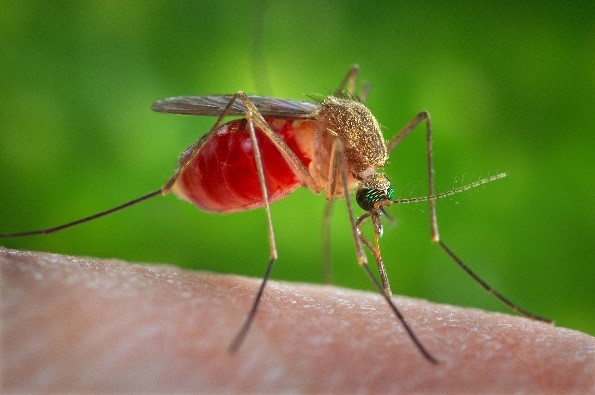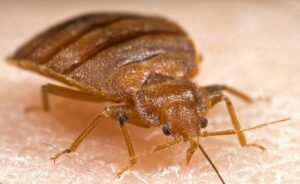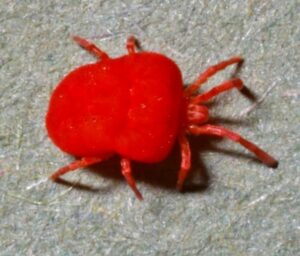Aedes Mosquito (Biting Nuisance Species)
A. aegypti, A. albopictus, and A. caspius
(A. aegypti is not reported from UAE)
General Description
Mosquitoes have four distinct developmental stages: egg, larva, pupa, and adult
Eggs:
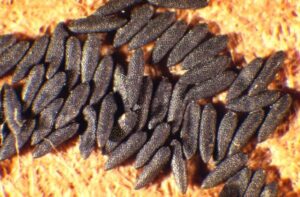
Eggs. |
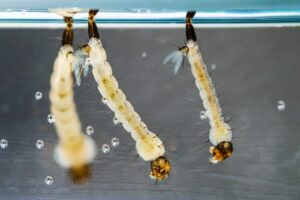
Larvae |
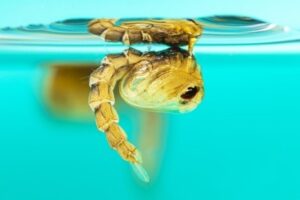
Pupa |

Adult |
Life Cycle and Common Characteristics

Life cycle takes about 7-10 days for an egg to
develop into an adult mosquito.
- Females lay their eggs as single units and deposit them on moist areas such as rock surfaces, moist earth, and inside walls of tree holes or containers above the water
- Eggs are almost transparent when first laid, but gradually darken to brown or black as they
- Eggs are elongated and oval in There are often fixed geometric shapes on its outer wall
- Eggs stick to container walls like glue. Eggs are able to withstand desiccation and can survive long periods until they are submerged in water and then begin to Eggs can survive dry conditions for up to 8 months.
- Mosquitoes only need a small amount of water to lay eggs.
- Larvae typically feed on the bottom of the
- in the water (aquatic).
- Larvae can be seen very active in the water (called “wigglers”).
- The larva goes through four stages until it reaches the pupal
- Larvae breathe air from openings (spiracles) at the posterior end of the body, through a structure termed a
- Larvae hang below the water surface with the tip of the siphon exposed to the
- Aedes species may complete larval development in as little as 4-5
- After the 4th larval instar mosquitoes’ larva complete its development, it molts into a non-feeding but highly mobile stage called the pupa.
- The pupa breathes through a pair of tube-like organs located in the ‘head’ end of the comma-shaped body.
- Pupae live in the water.
- The duration of the pupal stage is generally 2-3 days.
- After emerging from the pupa, the adult mosquito rests on the water surface for a short time allowing its wings and body to dry, before flying off in search of a They are usually near a breeding site at dusk.
Adult females bite people and animals in the early morning and before sunset, and they do not make a loud buzz and tend to crawl under clothes to bite.
- Females need blood to produce eggs. Males feed on plant juices and fruit nectars near the breeding site.
- Adult length is 5 mm.
- After feeding, female mosquitoes look for water sources to lay eggs.
- They don’t fly long distances. They only fly within a few blocks.
- aegyptimosquitoes live indoors and outdoors, while A. albopictus live outdoors.
- The life span of adult mosquitoes is not well Some species apparently live one or two months, although under unfavorable conditions this period may be greatly reduced.
- Adults that hibernate during winter may live for six months or more
Damage and Medical Implications
1- Yellow Fever:
It is a serious and deadly disease that is transmitted by female mosquito species such as:
- Aedes aegypti spreads globally in cities and on coasts.
- Aedes africanus lives in the forests of Africa and flies at night.
- Aedes simposoni lives in the forests of Africa and flies during the day.
There are two types of disease (1) yellow fever in cities and (2) yellow fever in forests. The first disease is epidemic and concerns only humans, and the second is non-epidemic and depends on the infection of other animals such as monkeys.
The disease is endemic in the continent of Africa and is carried by the females of the aforementioned mosquitoes. The disease is highly fatal, especially in places where people do not have immunity to the disease. The yellow fever virus was repeatedly isolated from mosquitoes and was also isolated from monkeys. With the exception of Sudan, the disease does not exist in any Arab country.
Symptoms of mild infection appear within a week and are represented by high fever, headache, mild general pain, and dizziness. In cases of severe infection, two manifestations of the disease are observed. In the first manifestation, infected individuals appear with a rapid rise in body temperature, headache, dizziness, and muscle pain. In the second manifestation, high fever, slow heart rate, and various symptoms of bleeding occur. In fatal cases, profuse vomiting of dark brown or black materials followed by collapse and death occurred.

